Report on Physiological Disorders: Diabetes Type 1 & Breast Cancer
VerifiedAdded on 2021/02/19
|8
|2078
|143
Report
AI Summary
This report delves into two significant physiological disorders: diabetes type 1 and breast cancer. It explores the nature and causes of each, including genetic and environmental factors. The report details the signs and symptoms, differentiating between those observed by medical professionals and those experienced by patients. It discusses diagnostic methods such as blood sugar tests, mammograms, and breast examinations, as well as treatment and management strategies. The report also examines the challenges in diagnosing these disorders based on their signs and symptoms. Furthermore, it investigates the physiology of the endocrine and hormone systems, highlighting their roles in energy metabolism. The interrelation between the endocrine and hormone systems is analyzed to understand how they function together to maintain bodily functions. The report concludes by emphasizing the importance of understanding these disorders for improved patient care and treatment planning, referencing various research articles and statistics from organizations like Diabetes UK and Breast Cancer Care.

PHYSIOLOGICAL
DISORDERS
DISORDERS
Paraphrase This Document
Need a fresh take? Get an instant paraphrase of this document with our AI Paraphraser

TABLE OF CONTENTS
INTRODUCTION...........................................................................................................................1
SECTION 1......................................................................................................................................1
P1 Nature and Causes.................................................................................................................1
P2 Signs and Symptoms...............................................................................................................2
P3 Diagnosis of physiological disorders......................................................................................3
M1 Difficulties involved in the diagnosis of disorders from their signs and symptoms.............4
SECTION 2......................................................................................................................................4
P4 Physiology of 2 named body systems in relation to energy metabolism in the body.............4
M2 Role of energy in the body....................................................................................................5
D2 Analysis of two body systems interrelate to perform named functions.................................5
CONCLUSION................................................................................................................................5
REFERENCES................................................................................................................................6
INTRODUCTION...........................................................................................................................1
SECTION 1......................................................................................................................................1
P1 Nature and Causes.................................................................................................................1
P2 Signs and Symptoms...............................................................................................................2
P3 Diagnosis of physiological disorders......................................................................................3
M1 Difficulties involved in the diagnosis of disorders from their signs and symptoms.............4
SECTION 2......................................................................................................................................4
P4 Physiology of 2 named body systems in relation to energy metabolism in the body.............4
M2 Role of energy in the body....................................................................................................5
D2 Analysis of two body systems interrelate to perform named functions.................................5
CONCLUSION................................................................................................................................5
REFERENCES................................................................................................................................6
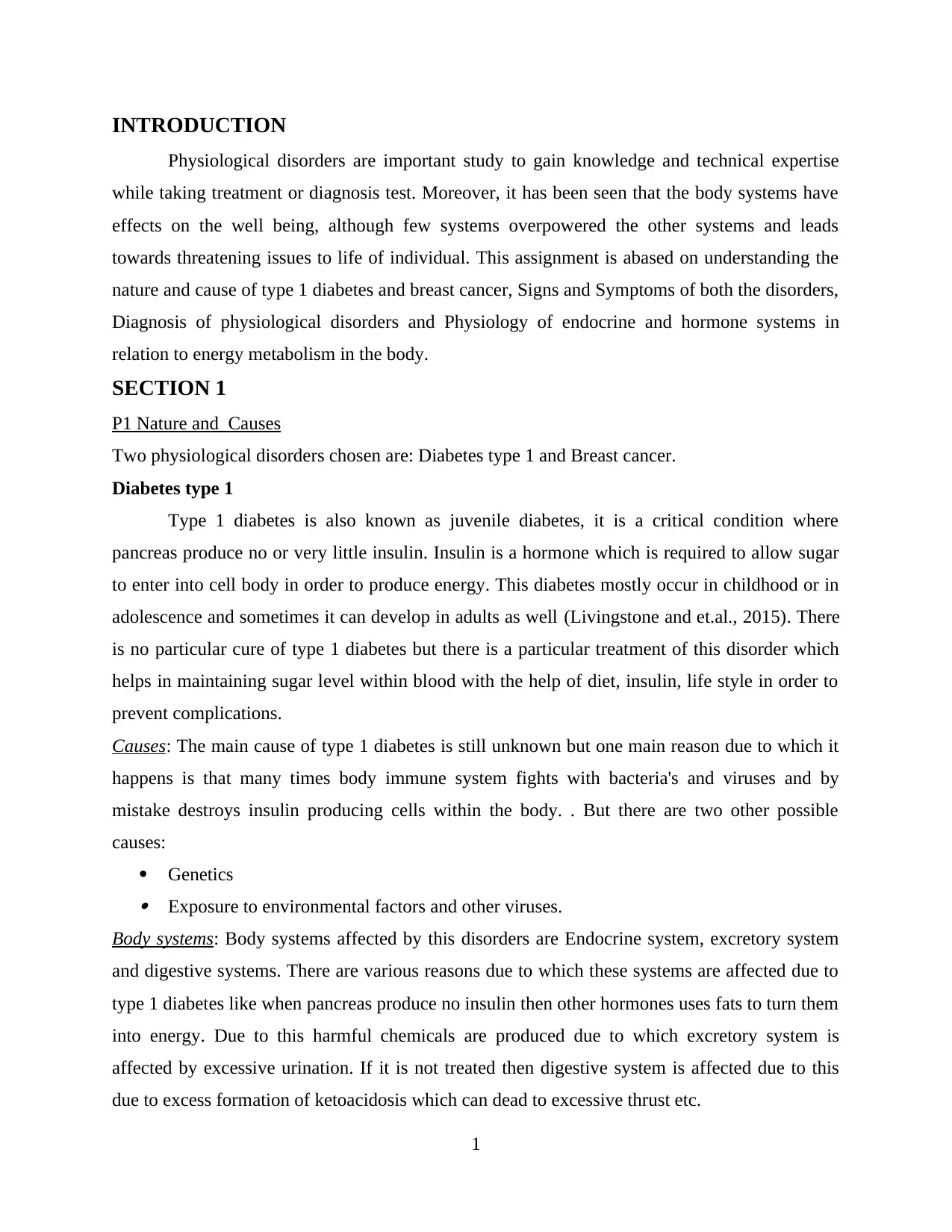
INTRODUCTION
Physiological disorders are important study to gain knowledge and technical expertise
while taking treatment or diagnosis test. Moreover, it has been seen that the body systems have
effects on the well being, although few systems overpowered the other systems and leads
towards threatening issues to life of individual. This assignment is abased on understanding the
nature and cause of type 1 diabetes and breast cancer, Signs and Symptoms of both the disorders,
Diagnosis of physiological disorders and Physiology of endocrine and hormone systems in
relation to energy metabolism in the body.
SECTION 1
P1 Nature and Causes
Two physiological disorders chosen are: Diabetes type 1 and Breast cancer.
Diabetes type 1
Type 1 diabetes is also known as juvenile diabetes, it is a critical condition where
pancreas produce no or very little insulin. Insulin is a hormone which is required to allow sugar
to enter into cell body in order to produce energy. This diabetes mostly occur in childhood or in
adolescence and sometimes it can develop in adults as well (Livingstone and et.al., 2015). There
is no particular cure of type 1 diabetes but there is a particular treatment of this disorder which
helps in maintaining sugar level within blood with the help of diet, insulin, life style in order to
prevent complications.
Causes: The main cause of type 1 diabetes is still unknown but one main reason due to which it
happens is that many times body immune system fights with bacteria's and viruses and by
mistake destroys insulin producing cells within the body. . But there are two other possible
causes:
Genetics Exposure to environmental factors and other viruses.
Body systems: Body systems affected by this disorders are Endocrine system, excretory system
and digestive systems. There are various reasons due to which these systems are affected due to
type 1 diabetes like when pancreas produce no insulin then other hormones uses fats to turn them
into energy. Due to this harmful chemicals are produced due to which excretory system is
affected by excessive urination. If it is not treated then digestive system is affected due to this
due to excess formation of ketoacidosis which can dead to excessive thrust etc.
1
Physiological disorders are important study to gain knowledge and technical expertise
while taking treatment or diagnosis test. Moreover, it has been seen that the body systems have
effects on the well being, although few systems overpowered the other systems and leads
towards threatening issues to life of individual. This assignment is abased on understanding the
nature and cause of type 1 diabetes and breast cancer, Signs and Symptoms of both the disorders,
Diagnosis of physiological disorders and Physiology of endocrine and hormone systems in
relation to energy metabolism in the body.
SECTION 1
P1 Nature and Causes
Two physiological disorders chosen are: Diabetes type 1 and Breast cancer.
Diabetes type 1
Type 1 diabetes is also known as juvenile diabetes, it is a critical condition where
pancreas produce no or very little insulin. Insulin is a hormone which is required to allow sugar
to enter into cell body in order to produce energy. This diabetes mostly occur in childhood or in
adolescence and sometimes it can develop in adults as well (Livingstone and et.al., 2015). There
is no particular cure of type 1 diabetes but there is a particular treatment of this disorder which
helps in maintaining sugar level within blood with the help of diet, insulin, life style in order to
prevent complications.
Causes: The main cause of type 1 diabetes is still unknown but one main reason due to which it
happens is that many times body immune system fights with bacteria's and viruses and by
mistake destroys insulin producing cells within the body. . But there are two other possible
causes:
Genetics Exposure to environmental factors and other viruses.
Body systems: Body systems affected by this disorders are Endocrine system, excretory system
and digestive systems. There are various reasons due to which these systems are affected due to
type 1 diabetes like when pancreas produce no insulin then other hormones uses fats to turn them
into energy. Due to this harmful chemicals are produced due to which excretory system is
affected by excessive urination. If it is not treated then digestive system is affected due to this
due to excess formation of ketoacidosis which can dead to excessive thrust etc.
1
⊘ This is a preview!⊘
Do you want full access?
Subscribe today to unlock all pages.

Trusted by 1+ million students worldwide

Statistics: As per a statistics (The British Diabetic Association operating as Diabetes UK,
2018): UK is the fifth largest country in the world where type one diabetes within children (Upto
14 years) is continuously increasing. As per the statistics 24.5 percent children per 100,00 are
diagnosed with this disease every year and each year this percentage is continuously increasing.
Breast cancer
Causes: there are various causes due to which breast cancer disorders occurs such as:
genetics: Sometimes due to genetic disorder breast cancer disorder occurs. Almost 5 to 10
cancer is passed from generation to generation within family. Environmental factors, lifestyle, hormones are the main reason due to which breast
cancer is increasing continuously.
Body systems: Body systems affected by this disorders are blood and circulatory system,
lymphatic system, Immune system, hormone system. There are various reasons due to which
these systems are affected due to breast cancer as blood cancer can easily get into lymph and
blood due to which other body parts can get affected (Oram and et.al., 2016). Due to this blood
and circulatory system is affected which as a result affects the overall immune system of the
body.
Statistics: As per a statistics (Brest Cancer care 2018): In UK every 1 in 8 women has a chance
of developing breast cancer in their lifetime i.e. one women is every 10 minutes is diagnosed
with breast cancer. Every month more than 5000 plus people are diagnosed with breast cancer.
P2 Signs and Symptoms
Sign Symptoms
Signs can be observed by doctors and
other peoples.
Sign can be defied as an objective
evidence of a disease which is observed
by others.
Example: Asthma, cancer, tuberculosis
and various others diagnosed by
doctors or any other healthcare
profession. .
Symptoms are observed by patients
themselves.
Symptoms is a subjective symptom of a
disease which is observed by the person
who feels it.
Itching, headache, body pain and any
other symptoms that are felt by patients
themselves.
Diabetes type 1
2
2018): UK is the fifth largest country in the world where type one diabetes within children (Upto
14 years) is continuously increasing. As per the statistics 24.5 percent children per 100,00 are
diagnosed with this disease every year and each year this percentage is continuously increasing.
Breast cancer
Causes: there are various causes due to which breast cancer disorders occurs such as:
genetics: Sometimes due to genetic disorder breast cancer disorder occurs. Almost 5 to 10
cancer is passed from generation to generation within family. Environmental factors, lifestyle, hormones are the main reason due to which breast
cancer is increasing continuously.
Body systems: Body systems affected by this disorders are blood and circulatory system,
lymphatic system, Immune system, hormone system. There are various reasons due to which
these systems are affected due to breast cancer as blood cancer can easily get into lymph and
blood due to which other body parts can get affected (Oram and et.al., 2016). Due to this blood
and circulatory system is affected which as a result affects the overall immune system of the
body.
Statistics: As per a statistics (Brest Cancer care 2018): In UK every 1 in 8 women has a chance
of developing breast cancer in their lifetime i.e. one women is every 10 minutes is diagnosed
with breast cancer. Every month more than 5000 plus people are diagnosed with breast cancer.
P2 Signs and Symptoms
Sign Symptoms
Signs can be observed by doctors and
other peoples.
Sign can be defied as an objective
evidence of a disease which is observed
by others.
Example: Asthma, cancer, tuberculosis
and various others diagnosed by
doctors or any other healthcare
profession. .
Symptoms are observed by patients
themselves.
Symptoms is a subjective symptom of a
disease which is observed by the person
who feels it.
Itching, headache, body pain and any
other symptoms that are felt by patients
themselves.
Diabetes type 1
2
Paraphrase This Document
Need a fresh take? Get an instant paraphrase of this document with our AI Paraphraser
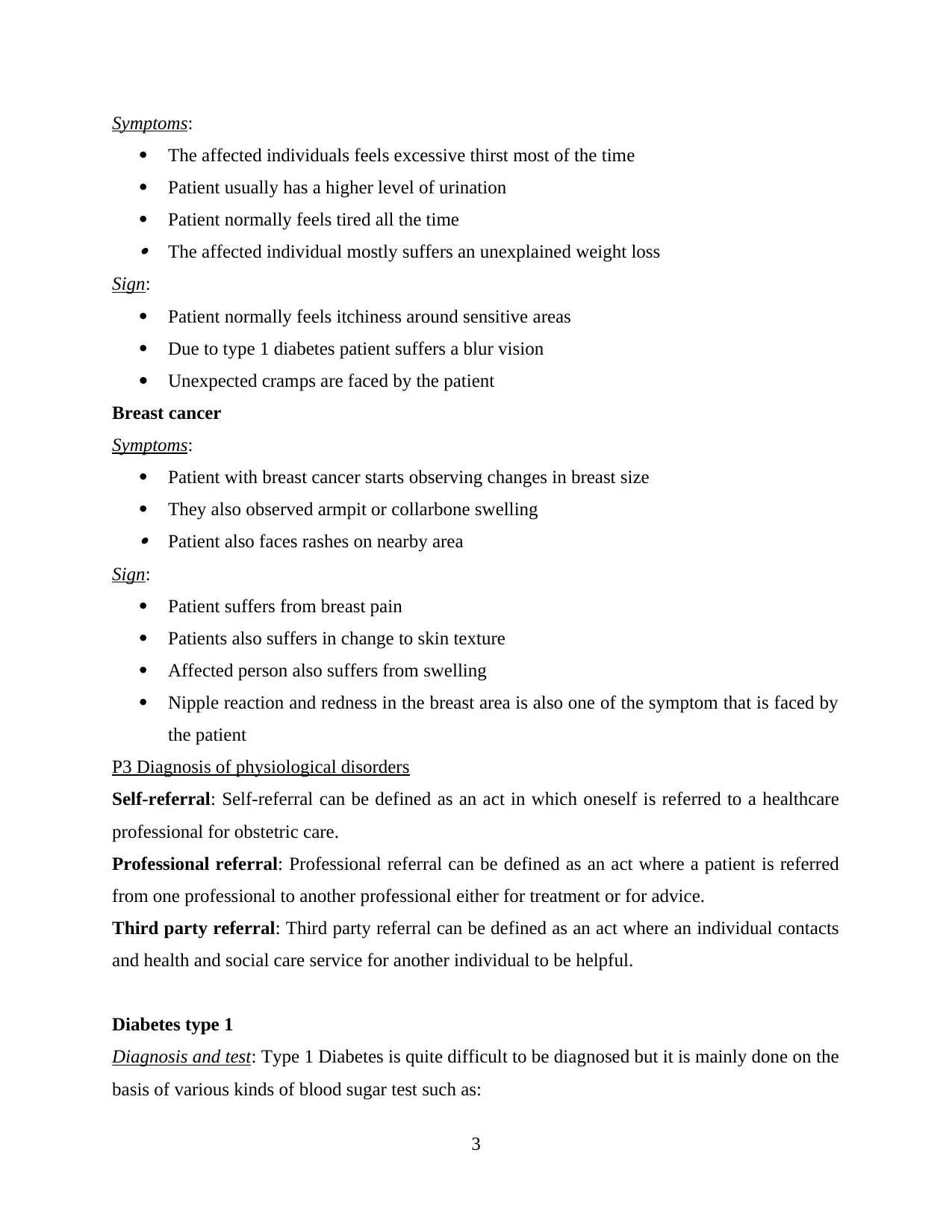
Symptoms:
The affected individuals feels excessive thirst most of the time
Patient usually has a higher level of urination
Patient normally feels tired all the time The affected individual mostly suffers an unexplained weight loss
Sign:
Patient normally feels itchiness around sensitive areas
Due to type 1 diabetes patient suffers a blur vision
Unexpected cramps are faced by the patient
Breast cancer
Symptoms:
Patient with breast cancer starts observing changes in breast size
They also observed armpit or collarbone swelling Patient also faces rashes on nearby area
Sign:
Patient suffers from breast pain
Patients also suffers in change to skin texture
Affected person also suffers from swelling
Nipple reaction and redness in the breast area is also one of the symptom that is faced by
the patient
P3 Diagnosis of physiological disorders
Self-referral: Self-referral can be defined as an act in which oneself is referred to a healthcare
professional for obstetric care.
Professional referral: Professional referral can be defined as an act where a patient is referred
from one professional to another professional either for treatment or for advice.
Third party referral: Third party referral can be defined as an act where an individual contacts
and health and social care service for another individual to be helpful.
Diabetes type 1
Diagnosis and test: Type 1 Diabetes is quite difficult to be diagnosed but it is mainly done on the
basis of various kinds of blood sugar test such as:
3
The affected individuals feels excessive thirst most of the time
Patient usually has a higher level of urination
Patient normally feels tired all the time The affected individual mostly suffers an unexplained weight loss
Sign:
Patient normally feels itchiness around sensitive areas
Due to type 1 diabetes patient suffers a blur vision
Unexpected cramps are faced by the patient
Breast cancer
Symptoms:
Patient with breast cancer starts observing changes in breast size
They also observed armpit or collarbone swelling Patient also faces rashes on nearby area
Sign:
Patient suffers from breast pain
Patients also suffers in change to skin texture
Affected person also suffers from swelling
Nipple reaction and redness in the breast area is also one of the symptom that is faced by
the patient
P3 Diagnosis of physiological disorders
Self-referral: Self-referral can be defined as an act in which oneself is referred to a healthcare
professional for obstetric care.
Professional referral: Professional referral can be defined as an act where a patient is referred
from one professional to another professional either for treatment or for advice.
Third party referral: Third party referral can be defined as an act where an individual contacts
and health and social care service for another individual to be helpful.
Diabetes type 1
Diagnosis and test: Type 1 Diabetes is quite difficult to be diagnosed but it is mainly done on the
basis of various kinds of blood sugar test such as:
3
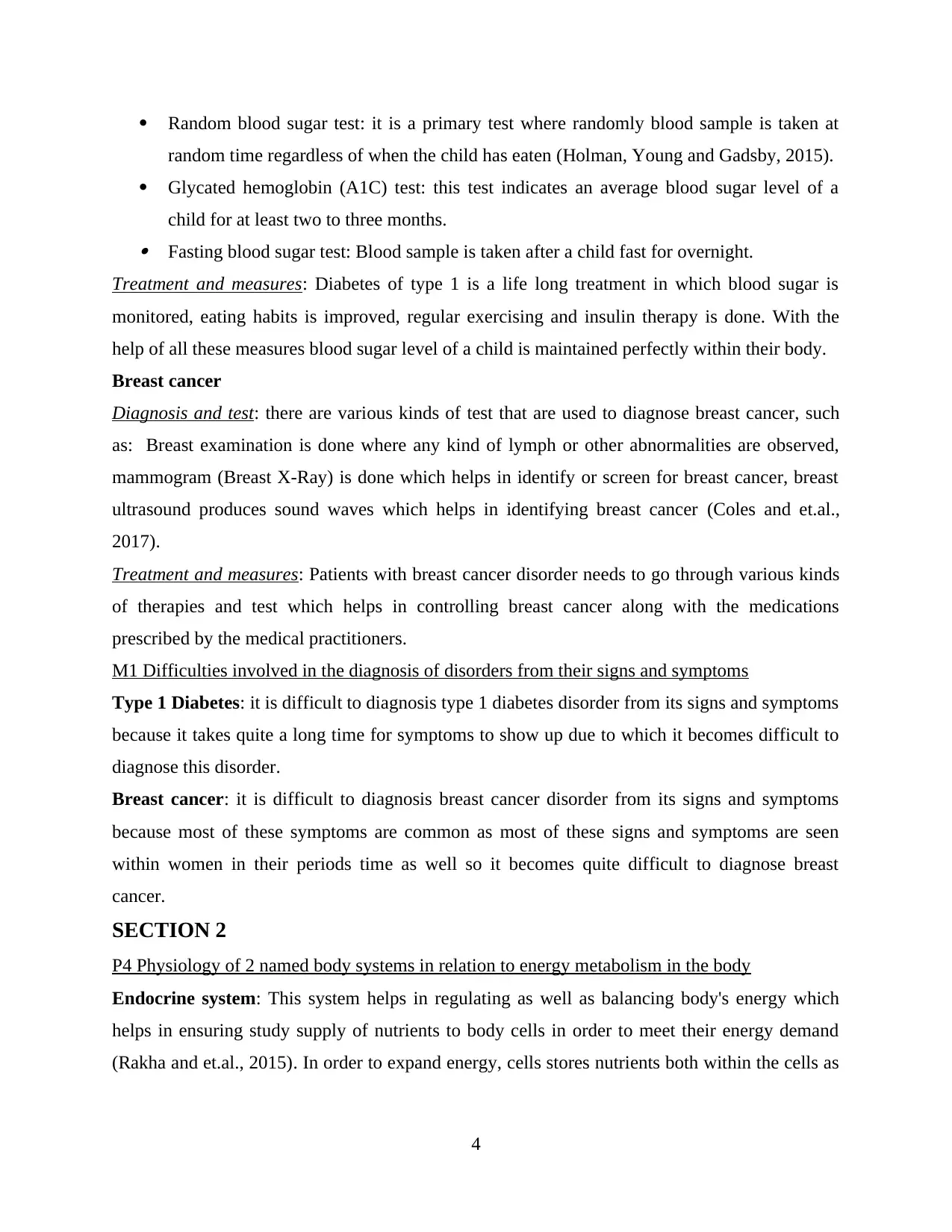
Random blood sugar test: it is a primary test where randomly blood sample is taken at
random time regardless of when the child has eaten (Holman, Young and Gadsby, 2015).
Glycated hemoglobin (A1C) test: this test indicates an average blood sugar level of a
child for at least two to three months. Fasting blood sugar test: Blood sample is taken after a child fast for overnight.
Treatment and measures: Diabetes of type 1 is a life long treatment in which blood sugar is
monitored, eating habits is improved, regular exercising and insulin therapy is done. With the
help of all these measures blood sugar level of a child is maintained perfectly within their body.
Breast cancer
Diagnosis and test: there are various kinds of test that are used to diagnose breast cancer, such
as: Breast examination is done where any kind of lymph or other abnormalities are observed,
mammogram (Breast X-Ray) is done which helps in identify or screen for breast cancer, breast
ultrasound produces sound waves which helps in identifying breast cancer (Coles and et.al.,
2017).
Treatment and measures: Patients with breast cancer disorder needs to go through various kinds
of therapies and test which helps in controlling breast cancer along with the medications
prescribed by the medical practitioners.
M1 Difficulties involved in the diagnosis of disorders from their signs and symptoms
Type 1 Diabetes: it is difficult to diagnosis type 1 diabetes disorder from its signs and symptoms
because it takes quite a long time for symptoms to show up due to which it becomes difficult to
diagnose this disorder.
Breast cancer: it is difficult to diagnosis breast cancer disorder from its signs and symptoms
because most of these symptoms are common as most of these signs and symptoms are seen
within women in their periods time as well so it becomes quite difficult to diagnose breast
cancer.
SECTION 2
P4 Physiology of 2 named body systems in relation to energy metabolism in the body
Endocrine system: This system helps in regulating as well as balancing body's energy which
helps in ensuring study supply of nutrients to body cells in order to meet their energy demand
(Rakha and et.al., 2015). In order to expand energy, cells stores nutrients both within the cells as
4
random time regardless of when the child has eaten (Holman, Young and Gadsby, 2015).
Glycated hemoglobin (A1C) test: this test indicates an average blood sugar level of a
child for at least two to three months. Fasting blood sugar test: Blood sample is taken after a child fast for overnight.
Treatment and measures: Diabetes of type 1 is a life long treatment in which blood sugar is
monitored, eating habits is improved, regular exercising and insulin therapy is done. With the
help of all these measures blood sugar level of a child is maintained perfectly within their body.
Breast cancer
Diagnosis and test: there are various kinds of test that are used to diagnose breast cancer, such
as: Breast examination is done where any kind of lymph or other abnormalities are observed,
mammogram (Breast X-Ray) is done which helps in identify or screen for breast cancer, breast
ultrasound produces sound waves which helps in identifying breast cancer (Coles and et.al.,
2017).
Treatment and measures: Patients with breast cancer disorder needs to go through various kinds
of therapies and test which helps in controlling breast cancer along with the medications
prescribed by the medical practitioners.
M1 Difficulties involved in the diagnosis of disorders from their signs and symptoms
Type 1 Diabetes: it is difficult to diagnosis type 1 diabetes disorder from its signs and symptoms
because it takes quite a long time for symptoms to show up due to which it becomes difficult to
diagnose this disorder.
Breast cancer: it is difficult to diagnosis breast cancer disorder from its signs and symptoms
because most of these symptoms are common as most of these signs and symptoms are seen
within women in their periods time as well so it becomes quite difficult to diagnose breast
cancer.
SECTION 2
P4 Physiology of 2 named body systems in relation to energy metabolism in the body
Endocrine system: This system helps in regulating as well as balancing body's energy which
helps in ensuring study supply of nutrients to body cells in order to meet their energy demand
(Rakha and et.al., 2015). In order to expand energy, cells stores nutrients both within the cells as
4
⊘ This is a preview!⊘
Do you want full access?
Subscribe today to unlock all pages.

Trusted by 1+ million students worldwide
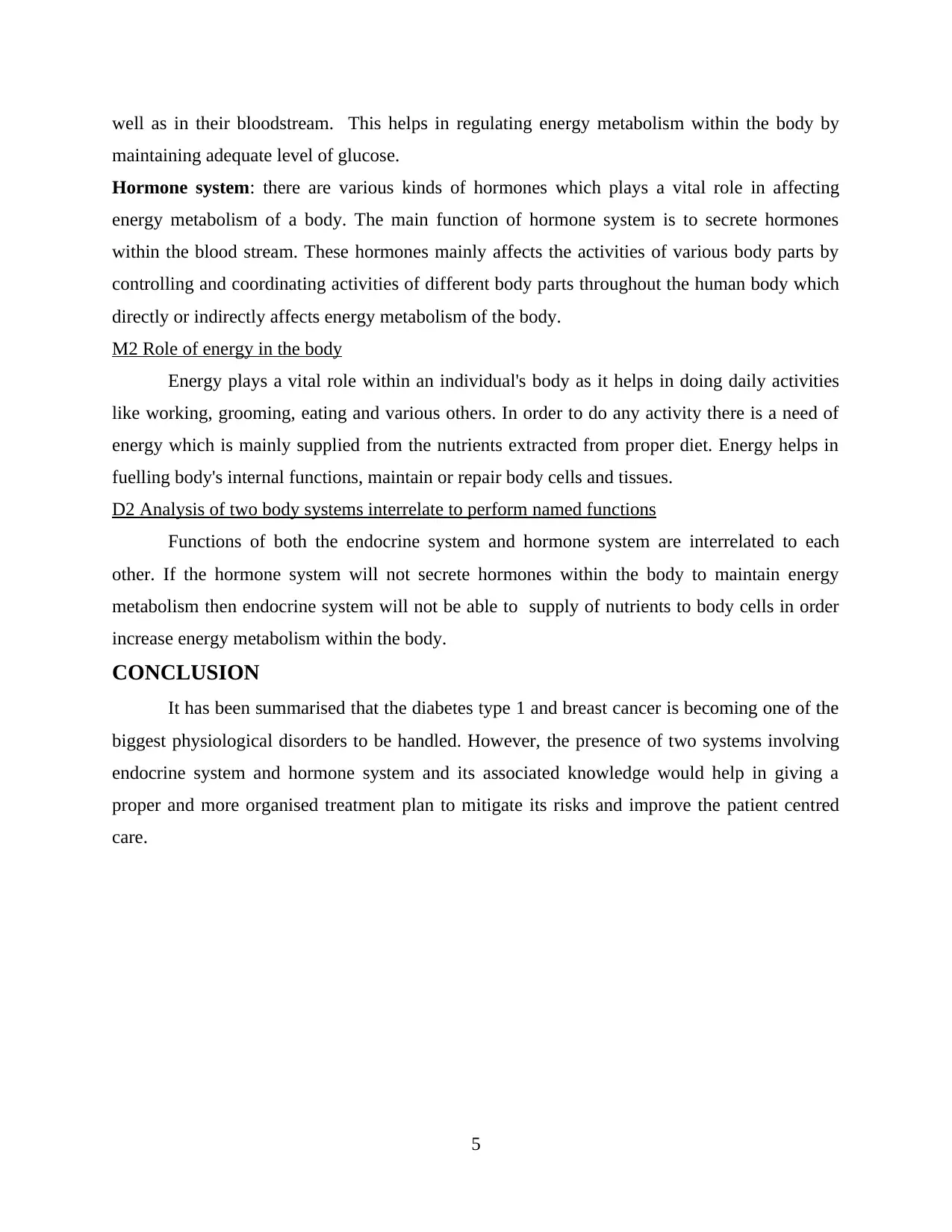
well as in their bloodstream. This helps in regulating energy metabolism within the body by
maintaining adequate level of glucose.
Hormone system: there are various kinds of hormones which plays a vital role in affecting
energy metabolism of a body. The main function of hormone system is to secrete hormones
within the blood stream. These hormones mainly affects the activities of various body parts by
controlling and coordinating activities of different body parts throughout the human body which
directly or indirectly affects energy metabolism of the body.
M2 Role of energy in the body
Energy plays a vital role within an individual's body as it helps in doing daily activities
like working, grooming, eating and various others. In order to do any activity there is a need of
energy which is mainly supplied from the nutrients extracted from proper diet. Energy helps in
fuelling body's internal functions, maintain or repair body cells and tissues.
D2 Analysis of two body systems interrelate to perform named functions
Functions of both the endocrine system and hormone system are interrelated to each
other. If the hormone system will not secrete hormones within the body to maintain energy
metabolism then endocrine system will not be able to supply of nutrients to body cells in order
increase energy metabolism within the body.
CONCLUSION
It has been summarised that the diabetes type 1 and breast cancer is becoming one of the
biggest physiological disorders to be handled. However, the presence of two systems involving
endocrine system and hormone system and its associated knowledge would help in giving a
proper and more organised treatment plan to mitigate its risks and improve the patient centred
care.
5
maintaining adequate level of glucose.
Hormone system: there are various kinds of hormones which plays a vital role in affecting
energy metabolism of a body. The main function of hormone system is to secrete hormones
within the blood stream. These hormones mainly affects the activities of various body parts by
controlling and coordinating activities of different body parts throughout the human body which
directly or indirectly affects energy metabolism of the body.
M2 Role of energy in the body
Energy plays a vital role within an individual's body as it helps in doing daily activities
like working, grooming, eating and various others. In order to do any activity there is a need of
energy which is mainly supplied from the nutrients extracted from proper diet. Energy helps in
fuelling body's internal functions, maintain or repair body cells and tissues.
D2 Analysis of two body systems interrelate to perform named functions
Functions of both the endocrine system and hormone system are interrelated to each
other. If the hormone system will not secrete hormones within the body to maintain energy
metabolism then endocrine system will not be able to supply of nutrients to body cells in order
increase energy metabolism within the body.
CONCLUSION
It has been summarised that the diabetes type 1 and breast cancer is becoming one of the
biggest physiological disorders to be handled. However, the presence of two systems involving
endocrine system and hormone system and its associated knowledge would help in giving a
proper and more organised treatment plan to mitigate its risks and improve the patient centred
care.
5
Paraphrase This Document
Need a fresh take? Get an instant paraphrase of this document with our AI Paraphraser
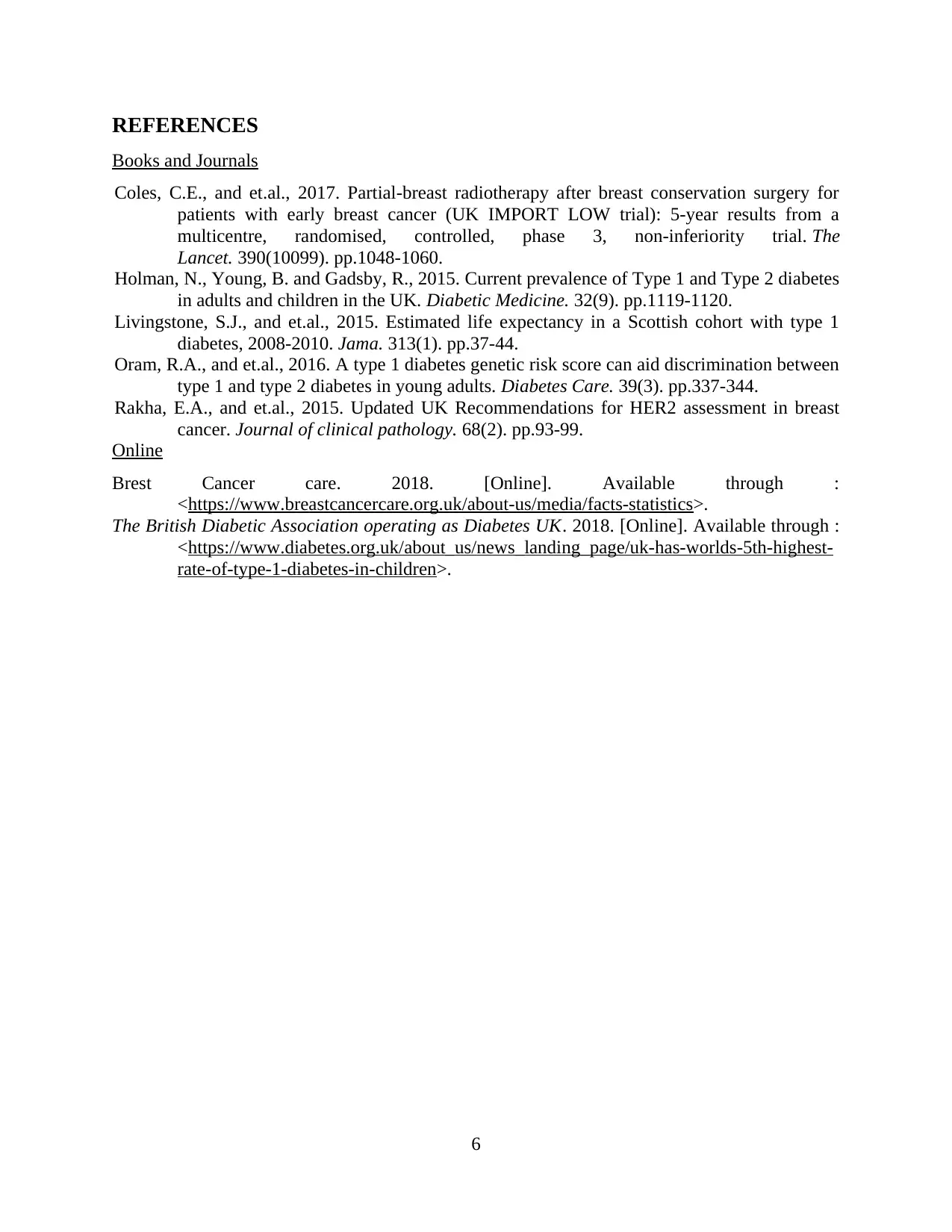
REFERENCES
Books and Journals
Coles, C.E., and et.al., 2017. Partial-breast radiotherapy after breast conservation surgery for
patients with early breast cancer (UK IMPORT LOW trial): 5-year results from a
multicentre, randomised, controlled, phase 3, non-inferiority trial. The
Lancet. 390(10099). pp.1048-1060.
Holman, N., Young, B. and Gadsby, R., 2015. Current prevalence of Type 1 and Type 2 diabetes
in adults and children in the UK. Diabetic Medicine. 32(9). pp.1119-1120.
Livingstone, S.J., and et.al., 2015. Estimated life expectancy in a Scottish cohort with type 1
diabetes, 2008-2010. Jama. 313(1). pp.37-44.
Oram, R.A., and et.al., 2016. A type 1 diabetes genetic risk score can aid discrimination between
type 1 and type 2 diabetes in young adults. Diabetes Care. 39(3). pp.337-344.
Rakha, E.A., and et.al., 2015. Updated UK Recommendations for HER2 assessment in breast
cancer. Journal of clinical pathology. 68(2). pp.93-99.
Online
Brest Cancer care. 2018. [Online]. Available through :
<https://www.breastcancercare.org.uk/about-us/media/facts-statistics>.
The British Diabetic Association operating as Diabetes UK. 2018. [Online]. Available through :
<https://www.diabetes.org.uk/about_us/news_landing_page/uk-has-worlds-5th-highest-
rate-of-type-1-diabetes-in-children>.
6
Books and Journals
Coles, C.E., and et.al., 2017. Partial-breast radiotherapy after breast conservation surgery for
patients with early breast cancer (UK IMPORT LOW trial): 5-year results from a
multicentre, randomised, controlled, phase 3, non-inferiority trial. The
Lancet. 390(10099). pp.1048-1060.
Holman, N., Young, B. and Gadsby, R., 2015. Current prevalence of Type 1 and Type 2 diabetes
in adults and children in the UK. Diabetic Medicine. 32(9). pp.1119-1120.
Livingstone, S.J., and et.al., 2015. Estimated life expectancy in a Scottish cohort with type 1
diabetes, 2008-2010. Jama. 313(1). pp.37-44.
Oram, R.A., and et.al., 2016. A type 1 diabetes genetic risk score can aid discrimination between
type 1 and type 2 diabetes in young adults. Diabetes Care. 39(3). pp.337-344.
Rakha, E.A., and et.al., 2015. Updated UK Recommendations for HER2 assessment in breast
cancer. Journal of clinical pathology. 68(2). pp.93-99.
Online
Brest Cancer care. 2018. [Online]. Available through :
<https://www.breastcancercare.org.uk/about-us/media/facts-statistics>.
The British Diabetic Association operating as Diabetes UK. 2018. [Online]. Available through :
<https://www.diabetes.org.uk/about_us/news_landing_page/uk-has-worlds-5th-highest-
rate-of-type-1-diabetes-in-children>.
6
1 out of 8
Related Documents
Your All-in-One AI-Powered Toolkit for Academic Success.
+13062052269
info@desklib.com
Available 24*7 on WhatsApp / Email
![[object Object]](/_next/static/media/star-bottom.7253800d.svg)
Unlock your academic potential
Copyright © 2020–2025 A2Z Services. All Rights Reserved. Developed and managed by ZUCOL.





